Looking to monetize your photography skills? Selling stock photos online offers a fantastic avenue, whether you’re a seasoned professional or just beginning to explore ways to generate passive income from your passion. Numerous online platforms connect photographers with businesses, agencies, and individuals seeking high-quality visuals for commercial projects.
Stock photo websites act as intermediaries, licensing your images to clients and providing you with a percentage of the revenue generated. This guide will explore 15 of the top websites for selling your photos online, coupled with a step-by-step roadmap to transform your photography into a profitable online venture.
Top Platforms for Selling Photos Online
1. Alamy
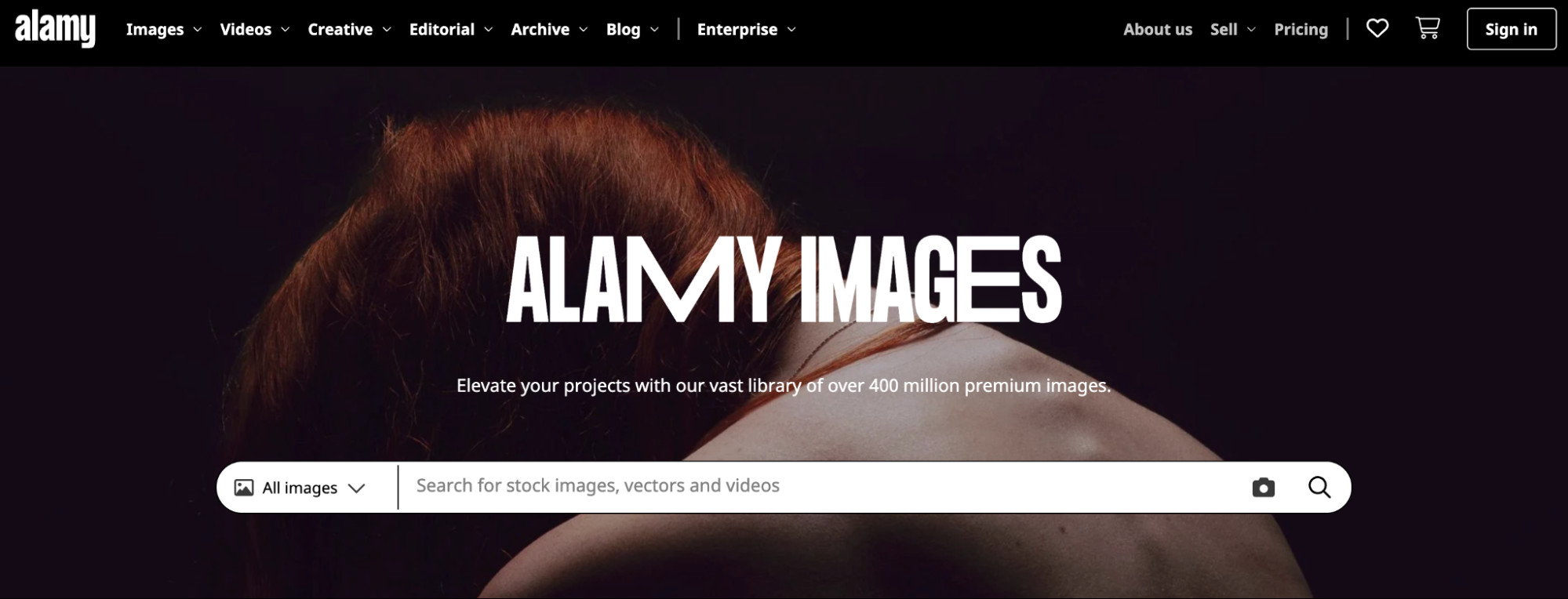 Alamy Images homepage showing a diverse range of royalty-free stock images and search bar, emphasizing its extensive collection for buyers.
Alamy Images homepage showing a diverse range of royalty-free stock images and search bar, emphasizing its extensive collection for buyers.
Alamy boasts one of the most extensive and diverse stock photo libraries available online, featuring millions of images, vector graphics, videos, and even 360-degree panoramic shots. This vast collection presents numerous opportunities for photographers to contribute and reach a broad audience. Alamy also offers Stockimo, an iOS app that allows you to upload and sell photos directly from your smartphone, expanding accessibility for contributors.
Commission Structure
Alamy provides monthly payouts to contributors with a commission model that ranges from 17% to 50% of sales. The exact percentage depends on factors like image popularity and the type of license purchased. Alamy distinguishes itself by not requiring long-term exclusivity contracts, and it offers payment flexibility in multiple currencies.
2. 500px
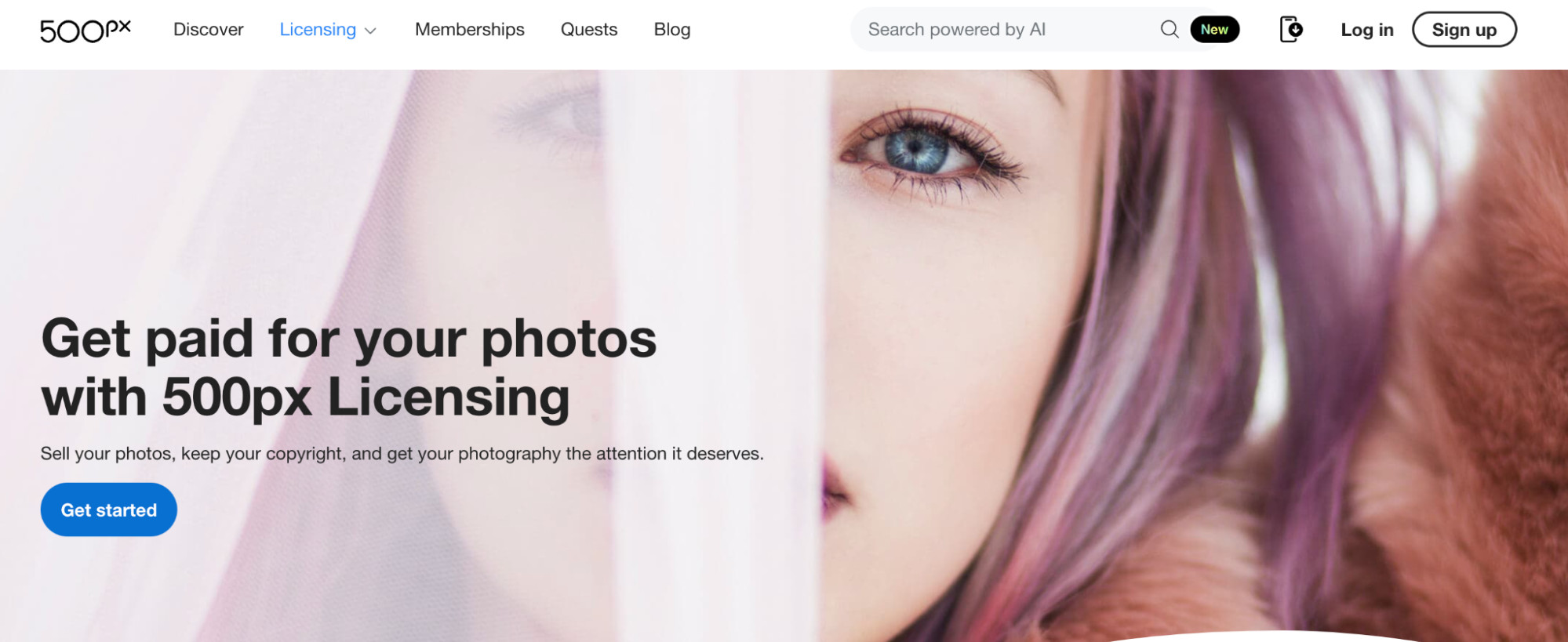 500px’s licensing homepage highlighting opportunities for photographers to earn money by licensing their photos within a community-focused platform.
500px’s licensing homepage highlighting opportunities for photographers to earn money by licensing their photos within a community-focused platform.
500px merges stock photo licensing with a thriving photography community. This platform hosts millions of photographers who license and sell their work. 500px’s proprietary “Pulse” algorithm is designed to showcase emerging talent and fresh content to potential buyers, providing visibility for photographers who meet the platform’s quality standards, regardless of their experience level.
Beyond its marketplace, 500px fosters a strong online community where photographers can connect, share feedback, participate in contests, and gain exposure. This dual nature of marketplace and community makes 500px an engaging platform for both selling and growing as a photographer.
Earning Potential
Photographers with paid memberships can earn up to 100% royalties on exclusive photos, making it a potentially lucrative option for those willing to commit to the platform.
3. Shutterstock
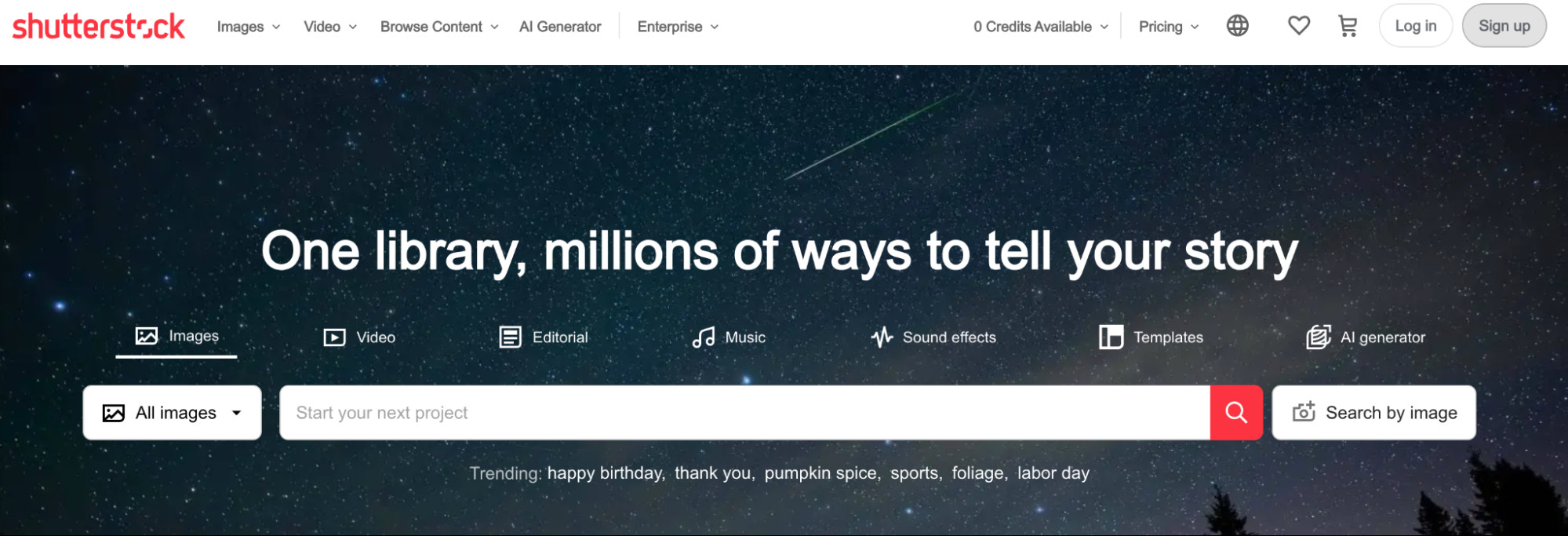 Shutterstock homepage showcasing royalty-free images, video, and music, emphasizing its role as a comprehensive content marketplace.
Shutterstock homepage showcasing royalty-free images, video, and music, emphasizing its role as a comprehensive content marketplace.
Shutterstock stands as one of the most recognized and widely used stock photography websites globally. A veteran in the industry, Shutterstock has distributed over $1 billion to its contributing artist community over the past 15 years, highlighting its significant market presence and revenue generation capabilities.
Shutterstock operates as a microstock site, characterized by lower image prices and non-exclusive licensing. Success on Shutterstock often hinges on contributing a large volume of images to maximize download potential. While individual image earnings might be lower compared to premium platforms, the high volume and accessibility of Shutterstock make it an excellent starting point for photographers new to selling stock photos.
Payment Details
Contributor payouts on Shutterstock are tiered, ranging from 15% to 40% of earnings, based on lifetime earnings. Shutterstock also offers an affiliate program that provides an additional income stream for referring new photographers or customers to the platform.
4. Getty Images
 Getty Images’ homepage featuring a search bar for high-quality photos and images, highlighting its reputation for premium stock content.
Getty Images’ homepage featuring a search bar for high-quality photos and images, highlighting its reputation for premium stock content.
Getty Images is synonymous with premium stock photography, attracting high-profile brands and publishers seeking exclusive, top-tier imagery. Along with its microstock subsidiary, iStock, Getty Images reaches an extensive global customer base of over 1.5 million.
Maintaining its reputation for quality, Getty Images has stringent acceptance criteria for photographers. Contributing to Getty Images signifies a commitment to high standards and professional-grade photography.
Application and Earnings
To become a Getty Images contributor, photographers must apply with a portfolio of sample images for review. Upon acceptance, commission rates range from 15% to 45% of the image license fee, reflecting the premium nature of the platform and its clientele.
5. iStock
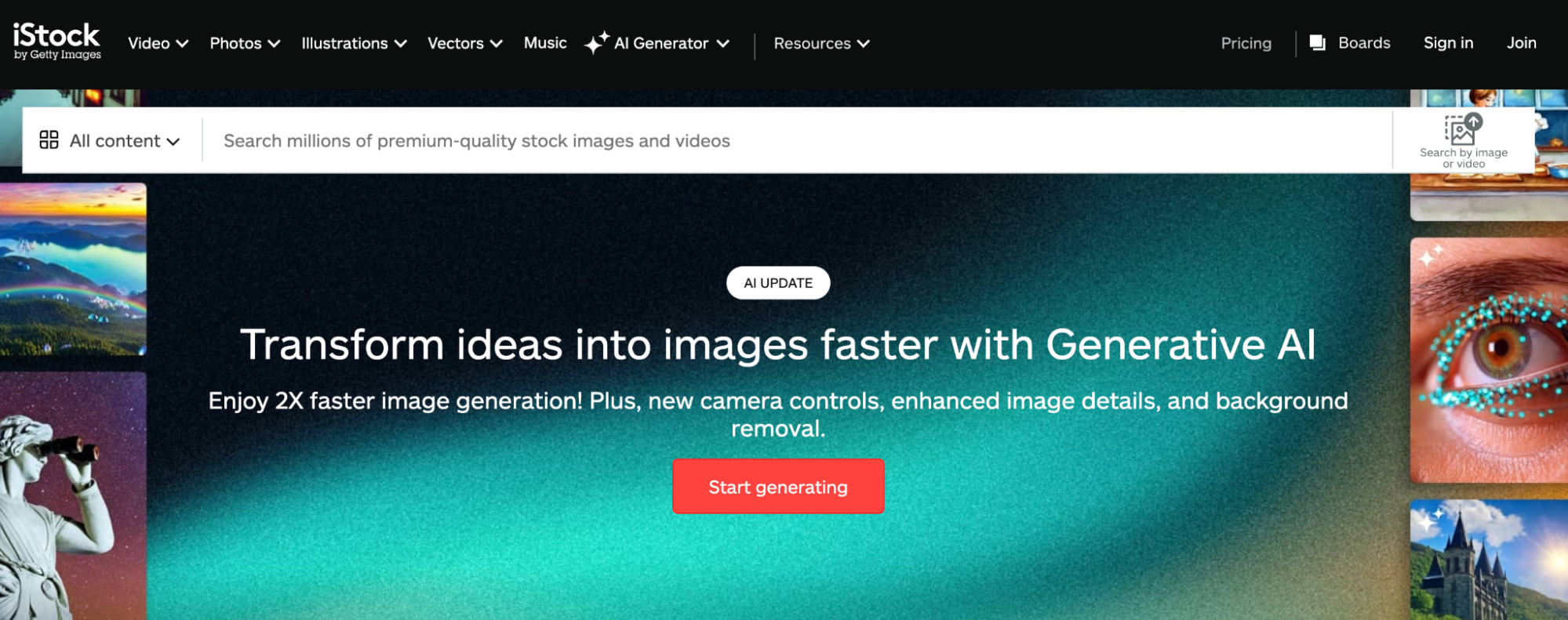 iStock landing page promoting its AI-powered image creator, alongside its stock photo offerings, indicating innovation and accessibility.
iStock landing page promoting its AI-powered image creator, alongside its stock photo offerings, indicating innovation and accessibility.
iStock operates as the non-exclusive counterpart to Getty Images. As a subsidiary of Getty Images, iStock offers a similar platform but with the key distinction of allowing non-exclusive image licensing. This means photographers can sell the same images on iStock and other stock photo agencies simultaneously, providing greater flexibility.
Joining iStock
Similar to Getty Images, photographers need to apply to become iStock contributors by submitting a selection of their work. The commission structure mirrors Getty Images, ranging from 15% to 45%, depending on the specific contributor agreement.
6. Stocksy
 Stocksy homepage showcasing artistic graphics and diverse imagery, reflecting its focus on curated, authentic stock photos.
Stocksy homepage showcasing artistic graphics and diverse imagery, reflecting its focus on curated, authentic stock photos.
Stocksy is recognized as a photographer-friendly platform, particularly appealing to those seeking higher payouts. Stocksy offers a 50% royalty for standard licenses and an even more generous 75% for extended licenses. A key requirement of Stocksy is exclusivity – photos sold on the platform must be exclusive to Stocksy.
Stocksy operates as an artist-owned cooperative, offering contributors a unique opportunity to become part-owners of the business. This cooperative model allows contributors to participate in the company’s direction and potentially receive patronage returns when the co-op achieves a surplus, fostering a sense of community and shared success.
Payment and Application
Stocksy pays contributors monthly via PayPal, Payoneer, or check, with a minimum payout threshold of $100. Photographers interested in joining Stocksy can find detailed information on their contributor application FAQ.
7. Picfair
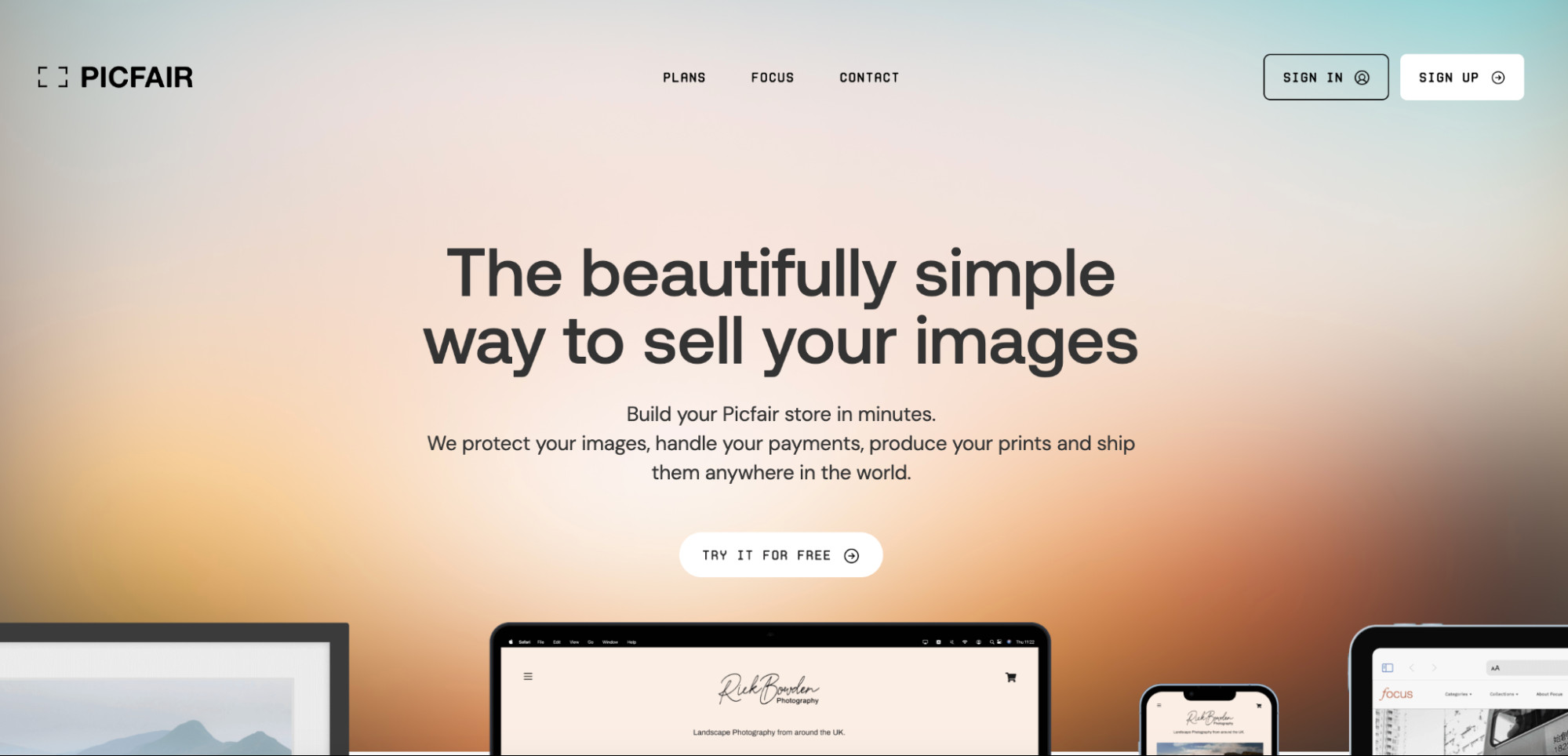 Picfair landing page promoting website builder tools for photographers, emphasizing control and customization for online portfolios.
Picfair landing page promoting website builder tools for photographers, emphasizing control and customization for online portfolios.
Picfair offers a distinctive approach by empowering photographers to create their own branded photography ecommerce websites. Picfair provides photographers with significant control over their online presence, allowing them to set their own prices for both digital downloads and prints. Picfair handles payment processing, print production, shipping, and digital image licenses, simplifying the sales process.
Pricing and Plans
Picfair operates on a subscription basis. The Plus plan, priced at $5 per month (billed annually), enables photographers to build a custom Picfair store capable of hosting up to 10,000 images for sale as prints or digital downloads, offering a comprehensive solution for independent online sales.
8. Adobe Stock
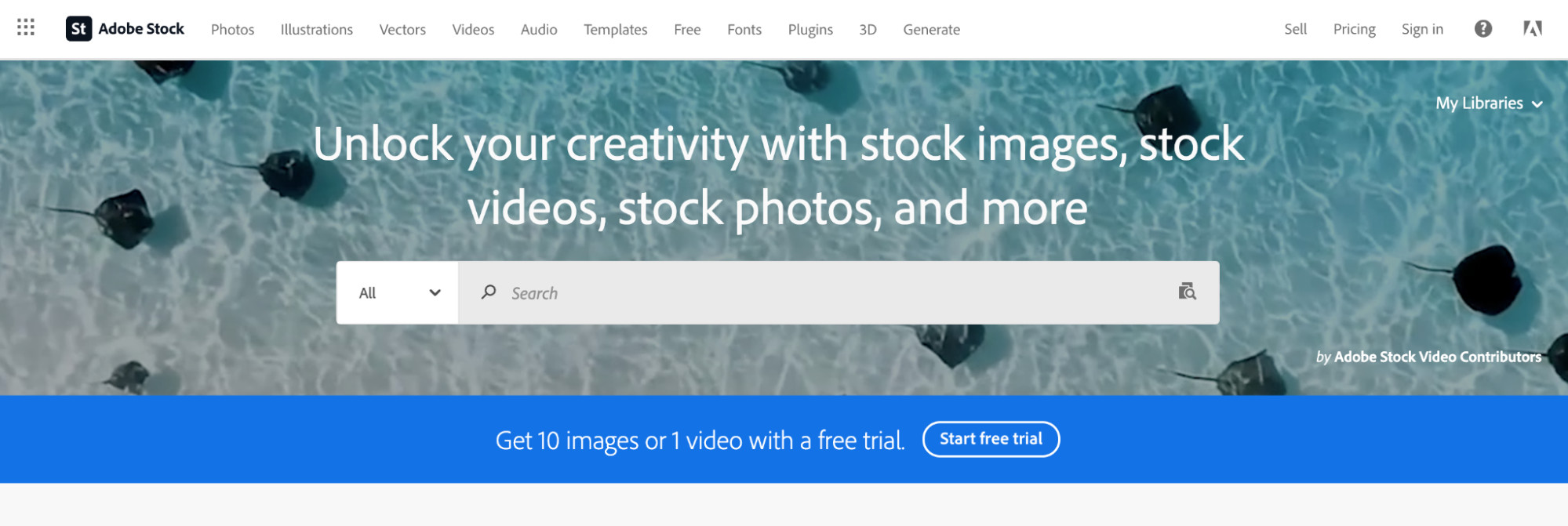 Adobe Stock homepage featuring a search bar against an underwater scene, highlighting integration with Adobe Creative Suite and diverse stock assets.
Adobe Stock homepage featuring a search bar against an underwater scene, highlighting integration with Adobe Creative Suite and diverse stock assets.
Adobe Stock seamlessly integrates with Adobe’s industry-leading Creative Suite software, making it a convenient option for photographers already working within the Adobe ecosystem. Adobe Stock accepts photos, videos, vectors, and illustrations, offering a wide range of asset types for contributors.
Integration and Royalties
Photographers can upload their content directly from Adobe Lightroom and Bridge, streamlining the submission process. Contributors linking their Adobe ID to Adobe Stock earn a 33% royalty on photo sales and 35% on video sales, providing a competitive commission rate within a well-established platform.
9. Envato Elements
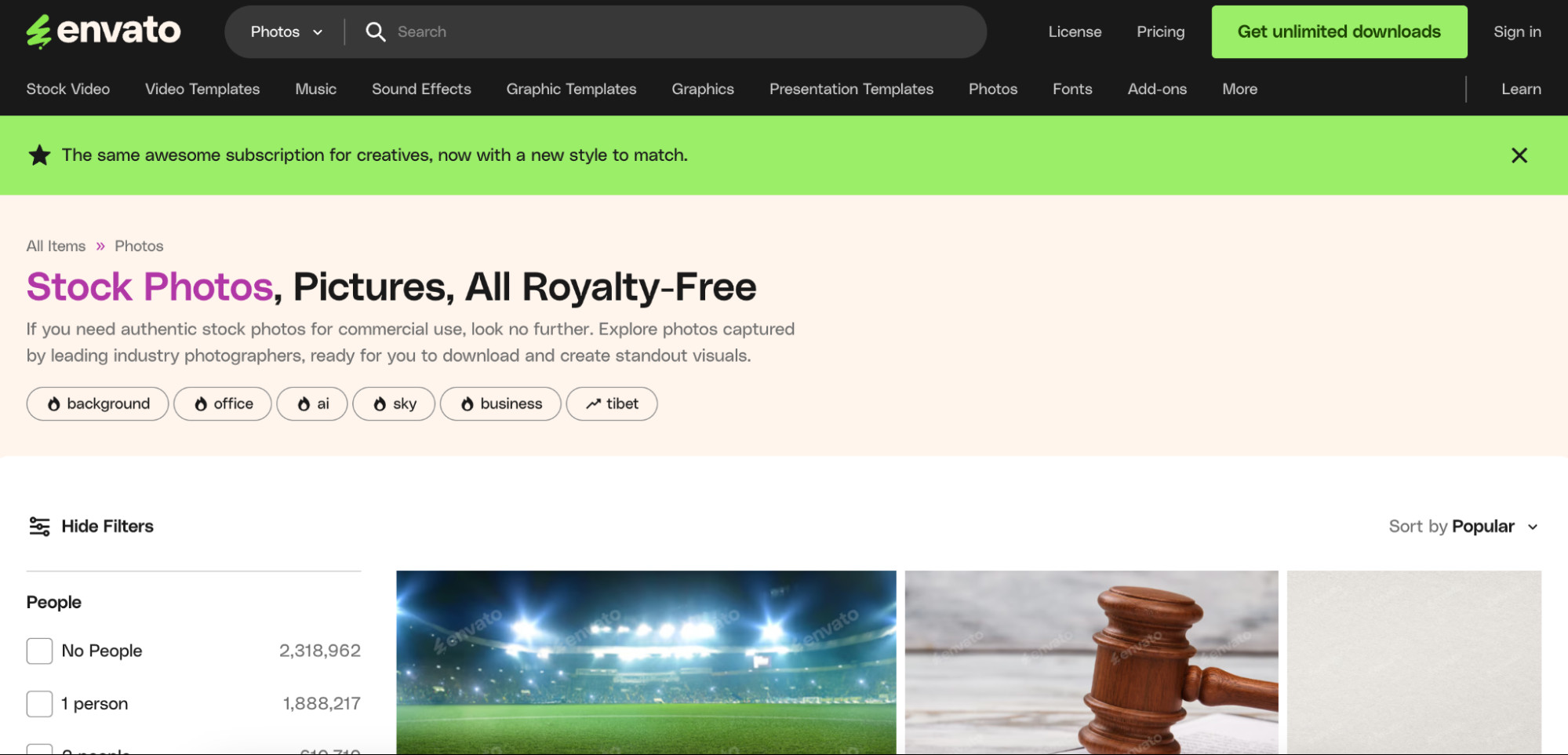 Landing page for stock photos on Envato Market, showcasing diverse image categories and highlighting subscription-based access to creative assets.
Landing page for stock photos on Envato Market, showcasing diverse image categories and highlighting subscription-based access to creative assets.
Envato Elements operates on a subscription model, offering unlimited downloads of stock photos and other creative assets to subscribers. As a contributor, you earn a share of the total subscription revenue generated by the platform. Envato Elements allows photographers to sell photos through their app or embed them on websites hosted on Envato’s domain.
Revenue Sharing
Envato Elements contributors earn between 25% and 50% of the net subscription revenue, with the specific percentage depending on factors like content popularity and subscriber engagement. This revenue-sharing model aligns contributor income with the overall success of the platform.
10. Unsplash+
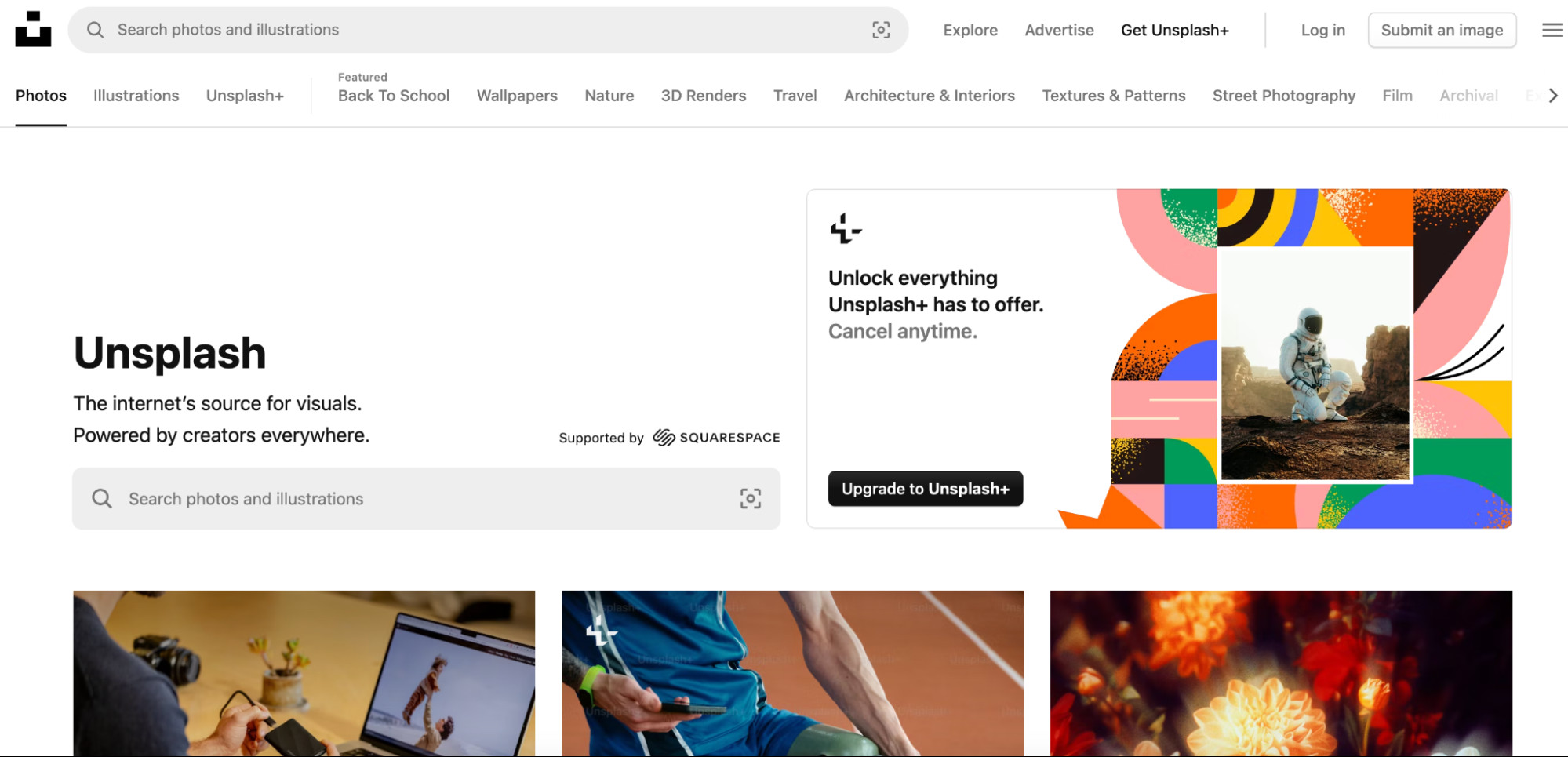 Unsplash homepage displaying stock photos and a call-to-action for Unsplash+, emphasizing its curated collection and opportunities for contributors.
Unsplash homepage displaying stock photos and a call-to-action for Unsplash+, emphasizing its curated collection and opportunities for contributors.
Unsplash+ represents a premium offering from Unsplash, known for its vast library of free stock photos. Unlike traditional stock photo sites, Unsplash+ pays photographers directly for image submissions based on assignments or briefs, rather than royalties per download. Unsplash+ is also owned by Getty Images.
Assignments and Payments
To contribute to Unsplash+, photographers need to complete an application and be accepted into the program. Once approved, contributors gain access to customer briefs and requests, allowing them to submit images that match specific needs. Payment rates for accepted images typically range from $5 to $30 per image, offering a direct payment model for commissioned work.
11. Dreamstime
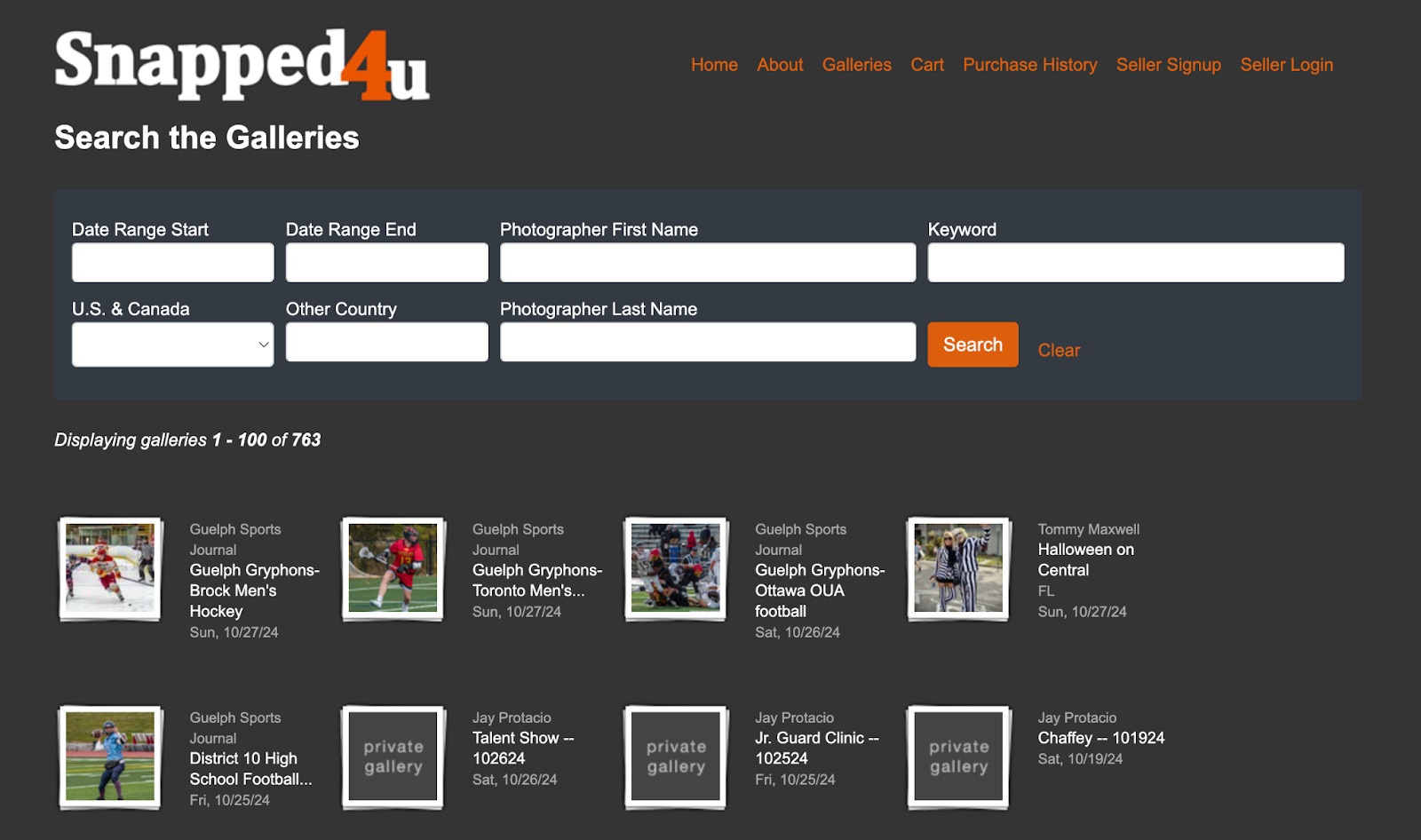 Snapped4U homepage displaying photos from sports photographers, highlighting its focus on event and portrait photography marketplace.
Snapped4U homepage displaying photos from sports photographers, highlighting its focus on event and portrait photography marketplace.
Dreamstime is a well-established microstock platform with a massive library of over 250 million royalty-free media files, including photos, vectors, videos, and audio. With a user base exceeding 50 million, Dreamstime offers photographers access to a substantial and active market for their work.
Commission and Exclusivity Bonuses
Dreamstime offers a revenue sharing structure ranging from 25% to 50% for non-exclusive content. Photographers who choose exclusivity with Dreamstime can earn an additional 10% commission and receive a bonus of 20¢ for each approved submission, incentivizing platform loyalty. Dreamstime also features an affiliate program for earning commissions by referring new contributors or customers.
12. Snapped4U
 Foap creator landing page advertising a mobile app for photographers, emphasizing direct sales to brands and individuals through missions and marketplace.
Foap creator landing page advertising a mobile app for photographers, emphasizing direct sales to brands and individuals through missions and marketplace.
Snapped4U specializes in serving photographers who focus on portrait and event photography. This platform enables photographers to create customized galleries, set their own image prices (up to $20 per image), and directly sell digital files to clients who attended specific events or portrait sessions.
Snapped4U is tailored for direct-to-consumer sales within the event and portrait niche. It’s important to note that Snapped4U does not accept travel, landscape, or still-life photography, focusing specifically on its target market.
Fees and Payments
Snapped4U has a one-time $10 registration fee upon signup and retains a 10% to 12% commission on sales. Photographer payouts are processed via PayPal on the 1st and 15th of each month, providing regular payment cycles.
13. Foap
 Foap creator landing page advertising a mobile app for photographers, emphasizing direct sales to brands and individuals through missions and marketplace.
Foap creator landing page advertising a mobile app for photographers, emphasizing direct sales to brands and individuals through missions and marketplace.
Foap facilitates direct connections between photographers and brands or individuals seeking commercial-quality images. Photographers on Foap can participate in “missions” where brands outline specific photo or video requirements and offer rewards to winning submissions. Foap has distributed over $3 million to creators to date.
Missions and Market Sales
Mission payouts on Foap range from $100 to $2,000, offering significant earning potential for successful submissions. Photographers can also sell individual photos directly through the Foap market. Foap takes a 50% commission on all sales, both through missions and marketplace transactions.
14. EyeEm
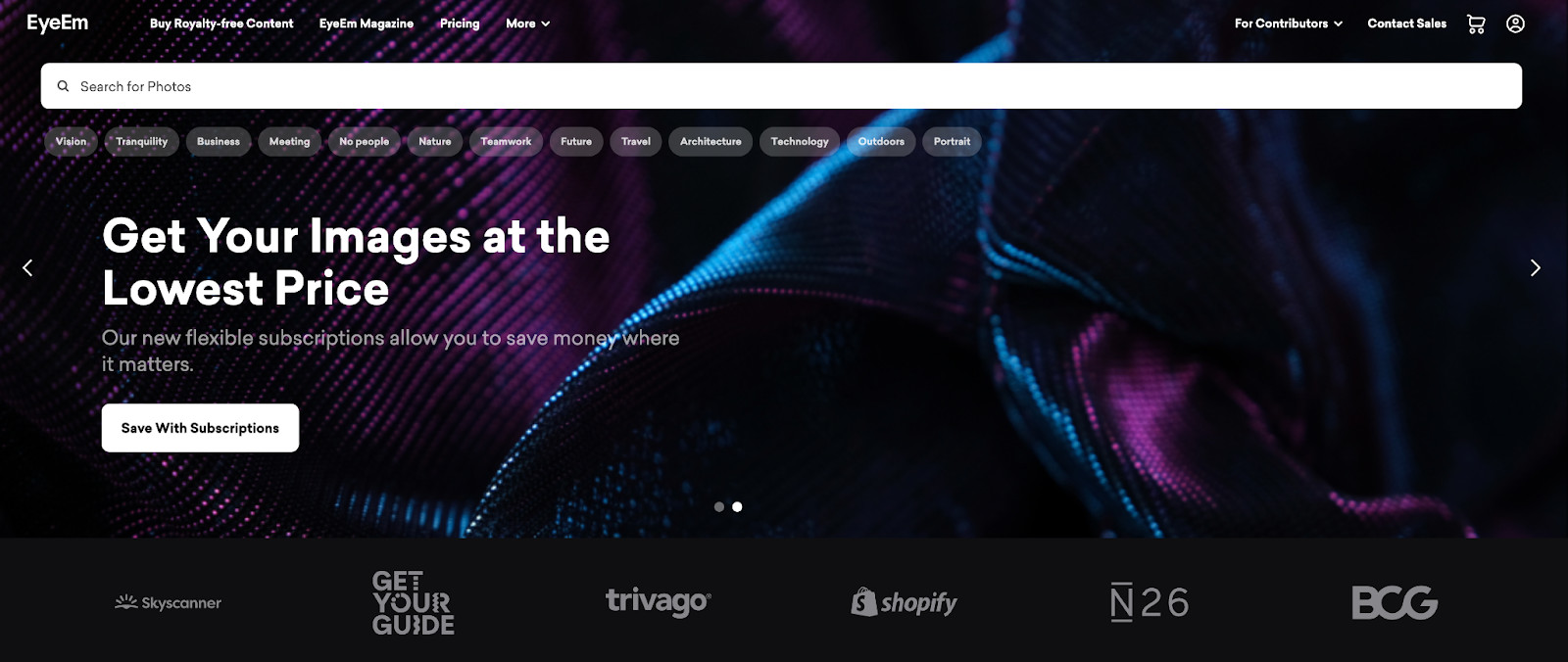 EyeEm homepage featuring a search bar and logos of high-profile clients, highlighting its marketplace and community for photographers and brands.
EyeEm homepage featuring a search bar and logos of high-profile clients, highlighting its marketplace and community for photographers and brands.
EyeEm blends a photography marketplace with a community platform, encouraging photographer interaction and collaboration. EyeEm frequently hosts missions that invite photographers to submit images based on specific themes or creative briefs, fostering engagement and providing exposure opportunities.
Commissions and Community
EyeEm contributors earn a 50% commission on sales made through the EyeEm marketplace. Payments are processed via PayPal. EyeEm’s community focus and mission-based approach provide unique avenues for photographers to gain recognition and sell their work.
15. Pond5 (for Videos)
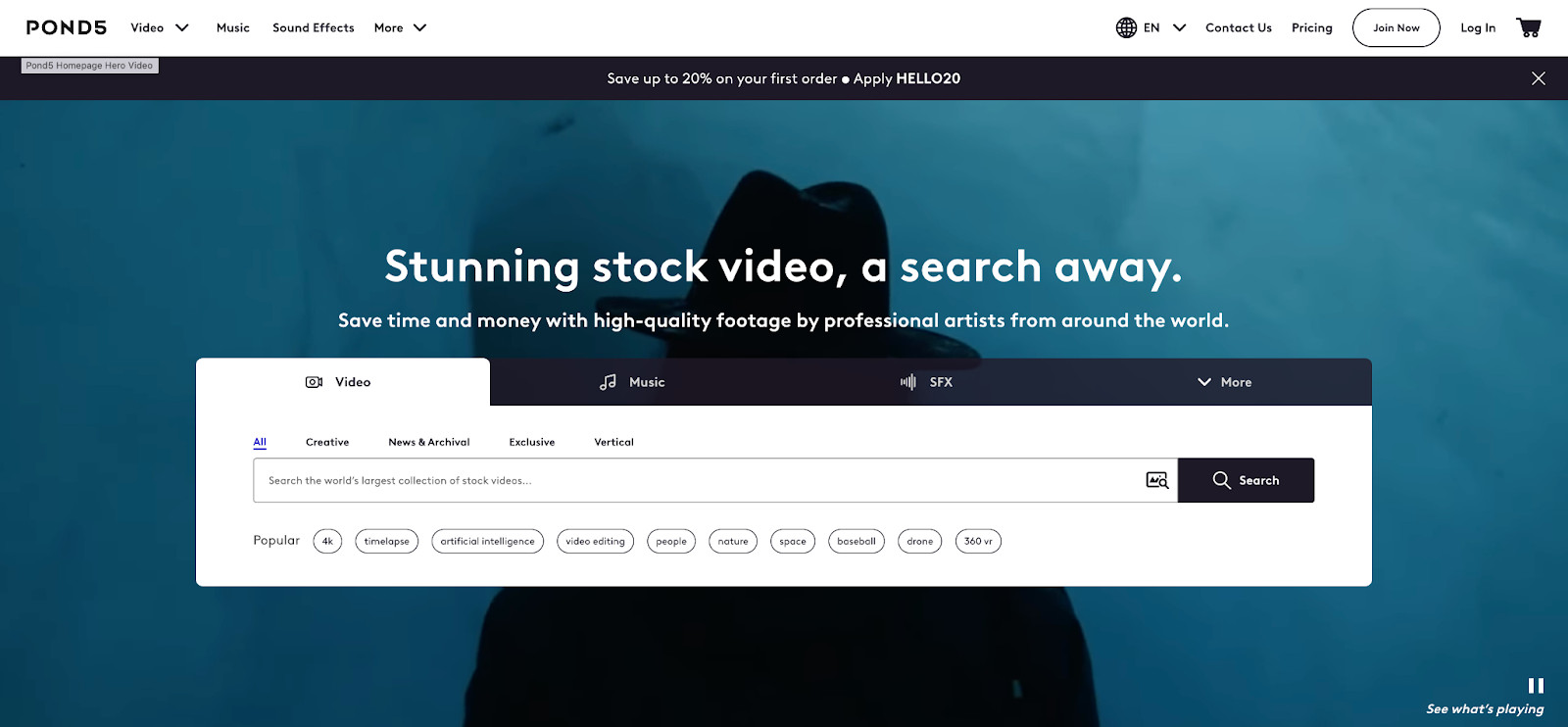 Pond5 homepage logo, indicating its specialization in video content and marketplace for video, music, and sound effects.
Pond5 homepage logo, indicating its specialization in video content and marketplace for video, music, and sound effects.
Pond5, unlike many other platforms focused primarily on photos, specializes in royalty-free video content, along with music, sound effects, and other media assets. Pond5 caters to a broad clientele, including major brands like the BBC and Disney, with contributor content being used in diverse projects ranging from ads to feature films.
Video-Focused Marketplace
Pond5 contributors create personalized storefronts to showcase their video and media portfolios. The platform also offers an Artist Portal where artists can respond to client briefs and requests, expanding opportunities for project-based earnings.
Royalties and Exclusivity Options
Video artists on Pond5 earn a 40% royalty share as a standard rate. Choosing exclusivity for content can increase royalties up to 60%, incentivizing contributors to commit exclusively to the platform. Pond5 also offers a referral program to generate additional income.
Essential Tips for Selling Stock Photos Effectively
Building a successful stock photo business requires more than just uploading images. Here are key strategies to maximize your earnings and grow your online presence:
Define Your Stock Photography Niche
Specialization can be a powerful tool in the stock photography market. Many successful photographers cultivate a distinctive style or focus on specific themes. Whether your passion lies in travel photography, fashion, nature, or food, establishing consistency in your portfolio is crucial for attracting buyers.
Finding your niche often involves exploring subjects you genuinely enjoy photographing that also resonate with market demand. Keyword research is invaluable for assessing the popularity of different topics. Tools like Google Trends can provide insights into trending image topics and help you identify profitable niches.
Leverage Instagram for Exposure
Similar to bloggers and YouTubers, photographers aiming to sell images online should prioritize building an engaged audience. Visual platforms, particularly Instagram, offer exceptional reach and visibility.
Utilize Instagram tools to identify relevant accounts to follow, engage with popular hashtags in your niche, and strategically grow your follower base. A strong Instagram presence can significantly increase your exposure to potential customers and drive traffic to your stock photo portfolios.
Cross-linking your social media accounts streamlines content sharing and amplifies your online visibility across platforms. For example, Instagram allows you to link your accounts to automatically post images to Facebook simultaneously, expanding your reach with minimal effort.
Integrate Ecommerce into Your Photography Website
Most photographers maintain a personal website to showcase their work to prospective clients. Integrating ecommerce functionality directly into your site offers a seamless sales channel. By embedding a Shopify Buy Button on your website, you can enable customers to purchase stock images directly from your portfolio.
Photographer Dave Sandford, for instance, features an online store integrated with his photography website, allowing visitors to purchase prints and calendars of his stunning wildlife photography.
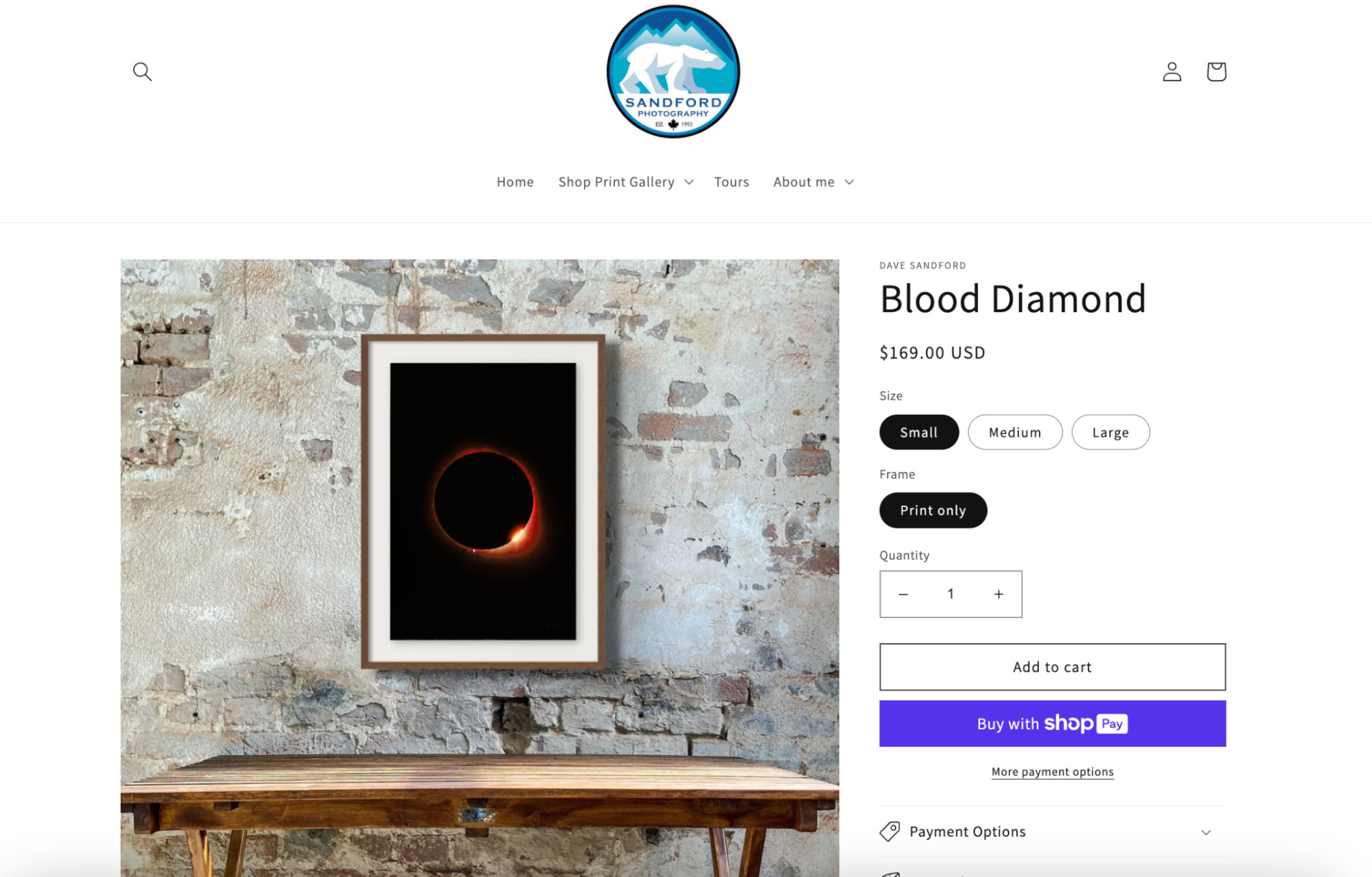 Product page for a moon print with red border showcased on a black background, demonstrating ecommerce integration on a photography website.
Product page for a moon print with red border showcased on a black background, demonstrating ecommerce integration on a photography website.
Creating a personalized portfolio page or online store on platforms like Shopify is a straightforward way to begin selling photos directly. Utilize pre-designed art and photography themes to establish your digital showroom quickly, or combine a free theme with a dedicated gallery app for enhanced visual presentation.
Understand Your Target Market
Defining your target market is essential for producing commercially viable stock photos. Knowing who is most likely to purchase your images—their interests, needs, and purchasing behaviors—will guide your photography and marketing efforts.
For example, if you specialize in wedding photography, your target market for stock photos isn’t likely to be engaged couples. Instead, it’s more likely to be businesses within the wedding industry, such as stationery brands or suit wholesalers, who need royalty-free images of wedding celebrations for their marketing collateral.
By understanding this buyer persona, you can tailor your photography to meet their specific needs, list your images on platforms frequented by this audience, and set prices that align with their budget and perceived value.
Setting Up Your Online Photography Portfolio: A Step-by-Step Guide
Creating a compelling online portfolio is a crucial step in selling your stock photos. Follow these steps to build a professional and effective online presence:
1. Choose the Right Platform for Your Needs
There’s no single “best” platform for monetizing your photos; the ideal choice depends on your specific goals and desired level of control over your photography business.
Here’s a breakdown of platform options based on different objectives:
- For hobbyists or passive income seekers: Stock photo submission sites like iStock or Alamy offer a low-commitment entry point.
- For brand assignments without direct pitching: Unsplash+ provides opportunities to respond to briefs from well-known brands.
- For full control over your photography business: Ecommerce platforms like Shopify empower you to build a comprehensive online store and manage all aspects of your sales.
2. Plan Your Portfolio’s Structure and Content
Your portfolio serves as your visual resume, showcasing your best work to potential clients and buyers. Pay close attention to these key elements:
- Layout: While photos should be the focal point, providing context with concise image descriptions enhances engagement and can influence purchase decisions. These mini-descriptions also improve your portfolio’s search engine optimization (SEO).
- Social Proof: Social proof elements, such as testimonials from satisfied customers or examples of your images used in successful campaigns, build credibility and trust.
- Categories and Organization: Well-organized portfolios are easier to navigate. Use tags and categories to help potential buyers browse your images effectively. For nature photographers, categories could include location, environment, subject, or date.
- Gallery Size and Quality: Curate your portfolio to showcase only your highest-quality images. Clients will judge your entire body of work based on what you present. Remove any images that don’t meet your quality standards and keep galleries focused on your best work.
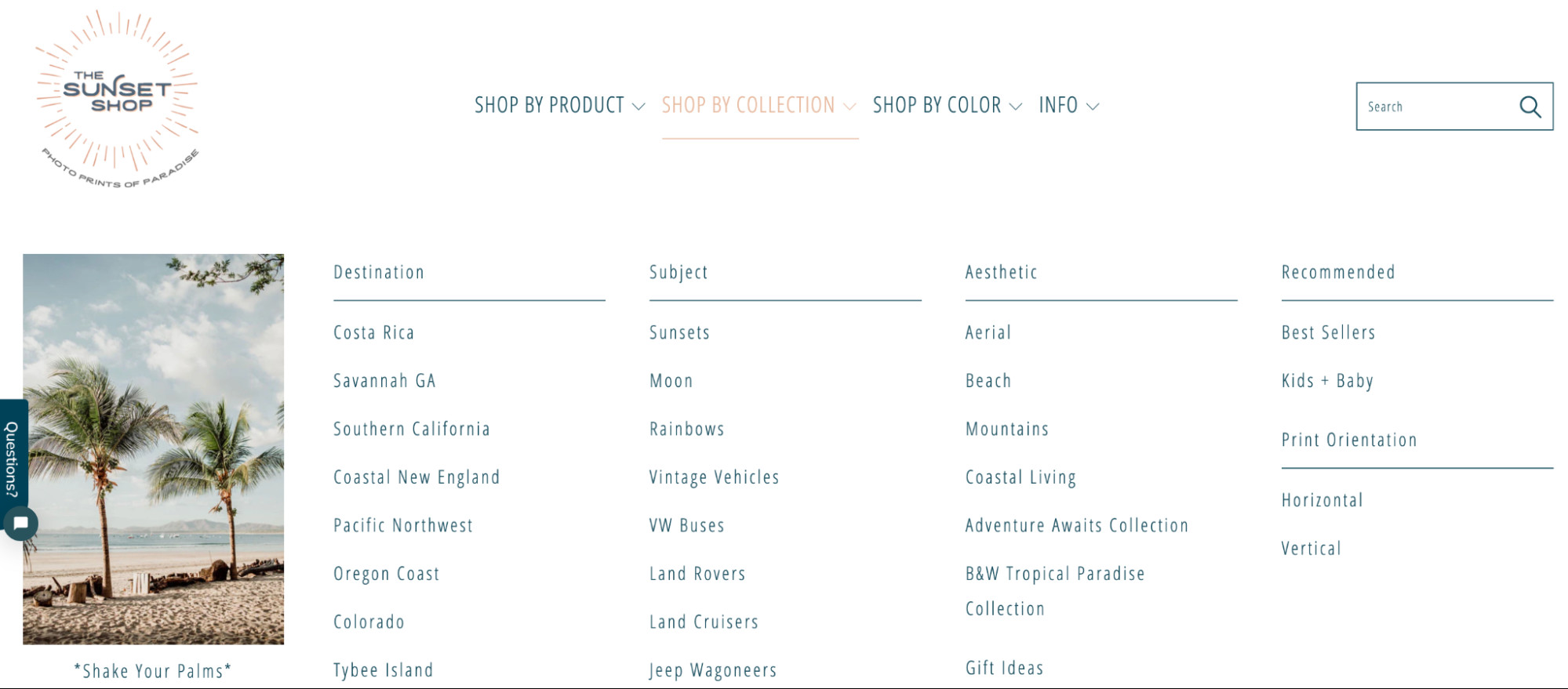 Example product categories on a photo print website including “Costa Rica”, “Sunset”, and “Mountains”, demonstrating effective portfolio organization.
Example product categories on a photo print website including “Costa Rica”, “Sunset”, and “Mountains”, demonstrating effective portfolio organization.
Well-structured categories, like those used by The Sunset Shop, enhance user experience and image discoverability.
3. Optimize Images for Web Performance
While high-resolution detail is essential for photography, website speed is paramount for user experience. Large image files can significantly slow down page loading times, and visitors are unlikely to wait for slow site speeds.
When uploading images to your online portfolio, prioritize optimization:
- Compress Image Sizes: Reduce file sizes as much as possible without sacrificing visual quality. Aim for compression levels between 60% and 80%.
- Use Descriptive File Names: Instead of generic names like “IMG_3542.jpg,” use descriptive file names like “summer-evening-nature.jpg” for improved SEO and organization.
- Write Alt Text: Alt text (alternative text) provides descriptions of your images for search engines and screen readers, improving accessibility and SEO.
4. Craft a Compelling About Page
People connect with people. An engaging About page helps potential customers learn about you and your photography journey.
Share your story, your passion for photography, and what makes your work unique. Discuss how you entered the field, your favorite subjects, and your sources of inspiration. Your About page is an opportunity to build a personal brand and establish a connection with your audience.
5. Implement Ecommerce Functionality for Sales
An integrated ecommerce platform streamlines the process of selling photos online. Using platforms like Shopify simplifies key aspects of online sales:
- Online Storefront: Create a professional storefront for self-service purchasing.
- Social Media Sales Channels: Extend your reach to social media platforms like Instagram Shop.
- Payment Processing and Taxes: Securely process payments and manage sales tax calculations.
- Product Delivery: Handle digital image delivery and physical print fulfillment.
- Marketing Campaign Management: Integrate marketing tools for promotions and customer engagement.
 Product page for a 5×7 printed photo of a beach, showcasing ecommerce functionality for selling photography prints online.
Product page for a 5×7 printed photo of a beach, showcasing ecommerce functionality for selling photography prints online.
The Bee & The Fox effectively utilizes Shopify to sell photography prints online, demonstrating seamless ecommerce integration.
6. Ensure Mobile Compatibility and Responsiveness
Mobile devices account for a significant portion of website traffic. Statistics indicate that over half of global website traffic originates from mobile devices. Therefore, ensuring your portfolio is fully mobile-compatible is crucial.
A mobile-friendly website requires responsive design that adapts to different screen sizes, vertical image layouts, and user-friendly, finger-friendly buttons for easy navigation on smaller screens.
7. Launch and Actively Promote Your Photos
Once your portfolio is set up, it’s time to promote your work and drive traffic. Employ these ecommerce marketing tactics:
- Social Media Reposting: Regularly share images on social media platforms.
- Pinterest Marketing: Pin photos on Pinterest, linking back to your portfolio site for visual discovery.
- Influencer Outreach: Gift free prints or digital images to relevant influencers for potential exposure.
- Behind-the-Scenes Content: Create engaging behind-the-scenes content on platforms like TikTok, YouTube, or Instagram Reels to showcase your process and personality.
- Email List Building: Offer website visitors a discount code in exchange for signing up for your email list to build a direct marketing channel.
Expanding Your Product Offerings: Prints and Photo Books
Beyond digital stock image licenses, consider expanding your revenue streams by selling physical products featuring your photography, such as prints and photo books.
Selling photos as prints on various media (paper, canvas, etc.) or physical products like mugs, t-shirts, and calendars can be surprisingly straightforward. Popular platforms and services for print-on-demand include: [List of POD services could be inserted here in a real article].
Partnering with a local photo lab for print and shipping or utilizing a print-on-demand company for dropshipping a wider range of products (prints, phone cases, pillows, etc.) can simplify fulfillment. Always order samples to verify product quality before offering them to customers.
Creating and Selling Photo Books Online
Photo books offer another avenue to monetize your photography. A cohesive theme and consistent photographic style enhance the appeal of photo books. Selling art online through photo books allows you to curate a collection of your work into a tangible product.
Print-on-demand services offer a low-risk way to test the market for photo books before investing in larger print runs.
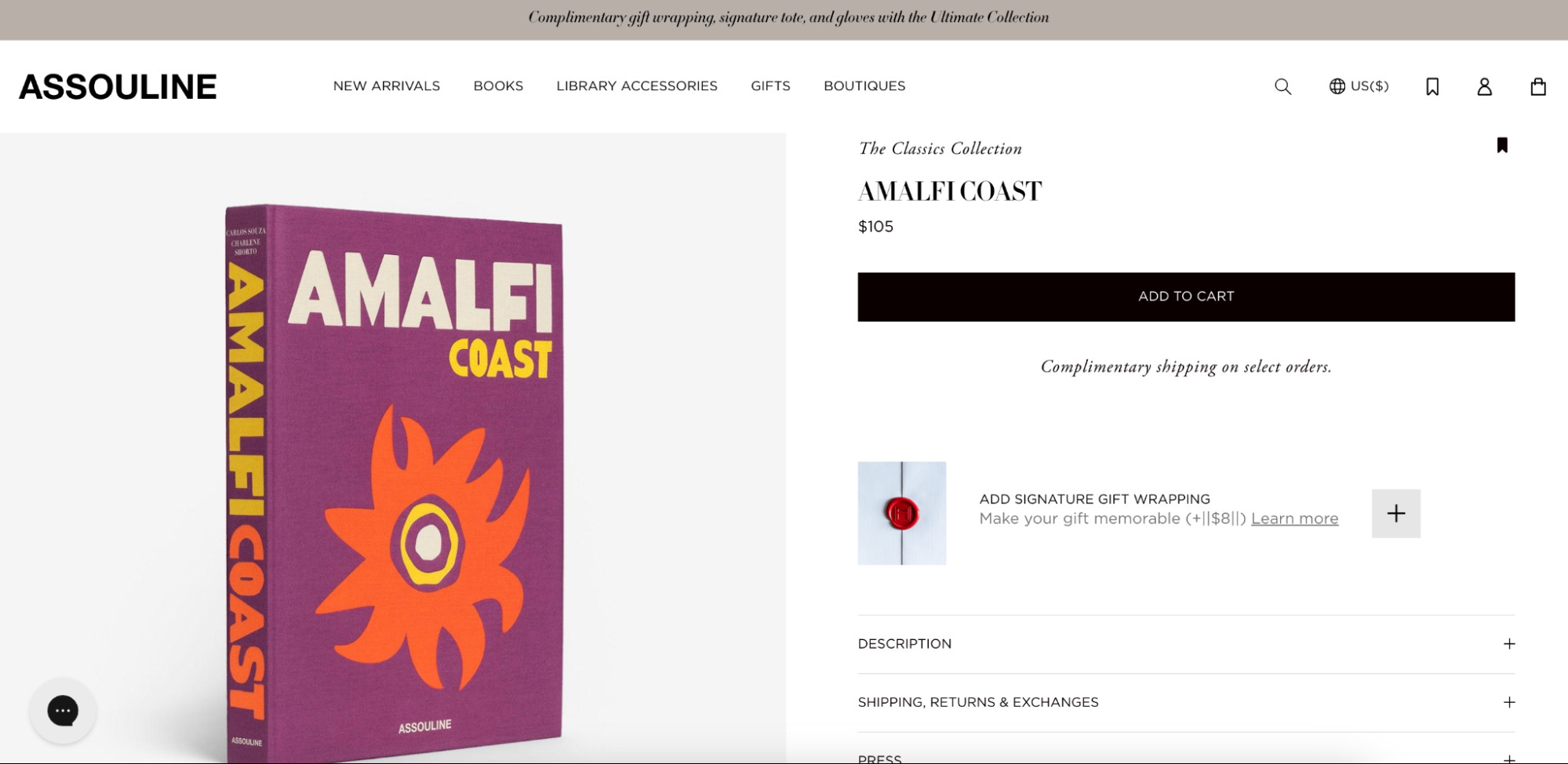 Photobook showcasing images from the Amalfi Coast, exemplifying premium photo book product for online sales.
Photobook showcasing images from the Amalfi Coast, exemplifying premium photo book product for online sales.
Assouline exemplifies premium photobook publishing, specializing in destination-themed coffee table books.
Offering Photography Services Online
In addition to stock photos and products, selling your photography services directly can be a significant income source. Whether you specialize in event photography, fashion shoots, or product photography, diverse business opportunities exist for professional photographers.
Freelance platforms like Fiverr and Upwork can connect you with clients seeking photography services. Local networking and virtual client meetings via video chat are also valuable.
Networking tips for selling photography services:
- Carry Business Cards: Use Shopify’s free business card generator to create professional cards.
- Optimize LinkedIn Profile: Showcase your work and optimize your profile for your primary service (e.g., event photographer).
- Attend Networking Events: Focus on events frequented by entrepreneurs and event organizers who often require photography services.
- Build Personal Brand: Regularly share your work on social media to stay top-of-mind for potential clients.
Utilize booking platforms like Setmore or SimplyBook.me (both offer free plans) to manage your schedule and allow clients to book appointments directly. Shopify users can integrate scheduling apps for direct booking from their websites.
Pricing Strategies for Selling Photos Online
Your pricing strategy is crucial for profitability. Consider these factors when setting prices for your photos:
- Market Research: Investigate competitor pricing on stock photo sites and survey your target market to understand price expectations.
- Profit Margins: Factor in photography costs (equipment, website hosting, marketing) and ensure your pricing covers expenses and generates profit.
- Usage Rights: Charge premium prices for exclusive licenses compared to non-exclusive options.
- Discounts and Promotions: Use discounts to incentivize first-time buyers or reward loyal customers.
- Product Bundles: Offer discounted bundles of related images to increase average order value. For instance, a single beach photo at $2.99 and a five-photo beach bundle at $9.99.
Legal Considerations for Selling Photos Online
Understanding basic legal terms and concepts related to photo licensing is essential for protecting your rights. This overview is not legal advice, but provides a general understanding of key terms:
Glossary of Legal Terms
- Editorial Use: License for use in news, blogs, magazines, and publications.
- Commercial Use: License for marketing and advertising purposes to promote products or services.
- Retail Use: License for incorporation into physical products for sale (prints, merchandise). Often considered within commercial use but can be distinct.
- Exclusive Use: License granting sole usage rights to the purchaser.
- Non-Exclusive Use: License allowing multiple buyers to use the same image. Typically lower priced than exclusive licenses.
- Public Domain: Images without copyright restrictions, free for commercial, editorial, and personal use. US federal government works often fall into this category.
- Creative Commons: Conditional usage licenses allowing use with specific restrictions, often requiring attribution. Creative Commons offers license badges.
- Royalty Free: License granting unlimited use for a one-time fee. Common and typically non-exclusive, thus lower priced.
- Rights Managed: One-time license with usage restrictions. Additional licenses required for further use.
- Right of Publicity: Protects the rights of individuals in photos, especially for commercial use. Requires explicit permission from subjects for commercial stock photo sales.
Addressing Photo Theft
Photo theft is a common concern. Watermarking your digital images before online sales offers a degree of protection. Use Photoshop or a watermark generator to apply watermarks. Smaller corner watermarks are less intrusive, while larger, semi-transparent watermarks offer stronger protection.
If you discover unauthorized use of your photos, a cease and desist letter is often effective. Alternatively, or in conjunction, send an invoice to the infringing party for usage fees, offering a choice between payment or image removal.
Always aim to receive credit when your work is used, even for editorial purposes. Backlinks to your portfolio site from external sources improve SEO and drive traffic.
Shopify supports entrepreneurs at all levels, from beginners to established retailers. Explore plans and pricing to launch your online photography business.
Further Reading
[Links to related dfphoto.net blog posts, if available, could be added here]
Frequently Asked Questions About Selling Photos Online
What is the most effective way to sell photographs?
Selling photographs as stock images through third-party websites like iStock, Shutterstock, or Alamy is generally considered the most efficient method. These platforms offer established marketplaces and streamlined sales processes.
Where are the best online platforms to sell my photos for income?
- Alamy
- 500px
- Shutterstock
- Getty Images
- iStock
- Stocksy
- Picfair
- Adobe Stock
- Envato Elements
- Unsplash+
How does stock photography generate income?
Stock photography websites act as agencies, licensing images uploaded by photographers. Clients purchase licenses for individual images at set prices, and the photographer receives a royalty payment for each license sold.
